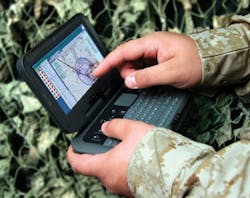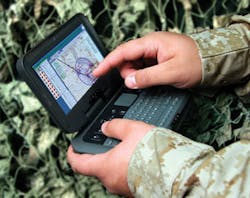By John McHale
SPOKANE VALLEY, Wash. - Engineers at General Dynamics Itronix in Spokane Valley, Wash., developed touch-screen display technology viewable in direct sunlight with practically the same clarity as a desktop indoors.
Itronix DynaVue technology eliminates the internal reflections that wash out display clarity through a design approach that focuses on standard contrast ratio and polarization techniques used in military cockpits under U.S. Navy MIL-HDBK-87213 Revision A Electronically/Optically Generated Airborne Displays, says Timothy Hill, senior marketing manager for Itronix. Contrast ratio is the key to outdoor viewability, he adds.
Sunlight reflecting off the many layers of the touch screen and LCD is the primary element that washes out the image, making fine detail difficult to distinguish and colors to become muted. “Reduce these reflections, both specular (mirror like) and diffuse (uneven), and you create a highly viewable display without increasing brightness,” Hill says.
This approach significantly reduces the drain on power that brightness approaches produce, says Ben Thacker, vice president of strategic marketing for General Dynamics Itronix.
The primary downside to rugged notebooks has been the display. The slightest amount of sunlight reflection, touch screen, or non-office-lighting conditions creates challenges that washout the display, rendering the image almost unreadable.
“According to our most recent user research, display quality and daylight viewability rank among the top three purchase criteria for rugged notebooks,” says David Krebs, a senior analyst at Venture Development Corp. in Natick, Mass. “The General Dynamics Itronix DynaVue display technology provides a truly impressive solution without compromising battery life or processing power,”
Contrast ratio determines the level of detail that can be seen on the display, with the higher ratio providing richer color and crisper lineation. Commercial notebooks’ contrast ratio is typically measured indoors under optimal and predictable conditions, Hill says. In the mobile environment contrast ratio takes on critical importance, as the lighting in vehicle and outdoor environments is not the typical subdued office lighting. In an outdoor setting, the light source can come from many angles and be very bright and highly reflective.
In this environment “daylight readability” based on U.S. Navy MIL-HDBK-87213 Revision A Electronically/Optically Generated Airborne Displays is more appropriate. MIL-HDBK-87213 Revision A provides specifications and guidance for the development of the primary flight displays and mission avionics controls and displays subsystem for aircraft and since the cockpit environment has similar lighting conditions as the outdoor worker, it is the ideal standard for mobile computers, Hill says.
Traditional approaches to solving this problem on touch-screen devices have been of a brute-force nature, which calls for simply increasing the display brightness (measured in NITs), Hill says. By adding additional backlights NIT ratings quickly increased from 250 to 500-and now to 1,000 NITs, he adds.
Displays that incorporate several backlights to generate adequate light (1,000 NITs) while improving brightness decrease battery efficiency because more power is needed to illuminate the display, Hill explains. Some companies use low-voltage or ultra-low-voltage processors which significantly reduce processor performance, or they will reduce the brightness by over 50 percent when the unit is undocked.
“Contrast ratio and color saturation remain low in direct sunlight making it difficult to distinguish fine details such as text and map details,” Hill says. “The extra light (NITs) overpowers the LCD pixels causing dark colors to appear grey and the image to become washed out.”
The more backlights you have, the more the overall brightness degrades over time, Hill adds.
The new Dynaview solves these problems with its focus on contrast ratio and provides better outdoor viewability with 1,000 NITs, uses lower-power backlighting solutions to provide optimum brightness without sacrificing battery life or processor performance, and has the same optimal performance on or off dock, Thacker says.
In a demonstration of DynaVue to Military & Aerospace Electronics staff, the screen was easily viewable in direct sunlight, especially when compared to contemporary laptops.
DynaVue is available on the company’s GoBook rugged notebooks and tablet PCs.
For more information visit www.gd-itronix.com.




